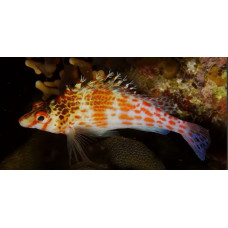Latin name
Cirrhitichthys oxycephalus
Other name
Pixy hawkfish, sharp-headed hawkfish.
Identification
These fish have an oval, moderately compressed body with a pointed snout of straight profile. The posterior margin of the anterior nostril has a fringe of antennae. The mouth is moderately large, with a row of small fang-like teeth on the outer jaw and a band of simple teeth on the inner jaw. The teeth are located in the center and on the sides of the palate. The preoperculum has large serrations and the gill cover has 2 flattened spines.
Features of fish fins
The dorsal fin has 10 spines and 12-13 soft rays, while the anal fin has 3 spines and 6 soft rays. The dorsal fin is solid, with a notch separating the spine and soft ray portions of the fin, while the webs between the spines are deeply incised and there is a cluster of pinnules at the end of each spine. The caudal fin is truncated. The lower 5-7 pectoral fin rays are stout, noticeably longer than the other pectoral fin rays, and separated by deep incisions in the webbing. The upper 1-2nd and lower 6-7th pectoral fin rays are unbranched. The pelvic fin consists of a single spine and 5 soft rays and begins behind the base of the pectoral fin.
Fish colouring
It is a species with varied coloration, the background color varies from whitish to pink, marked with reddish brown, grayish or bright reddish-orange spots, the smallest along the lateral line. The spiny part of the dorsal fin is covered with large spots, while the soft part of the dorsal fin is spotted, as is the caudal fin. The pectoral fins are pinkish red, while the pelvic fins are transparent.
Distribution
It is widely distributed throughout the Indian and Pacific Oceans. It occurs from the Red Sea south along the coast of East Africa to South Africa and east through the Indian Ocean into the Pacific Ocean to the Marquesas Islands, south to Australia and north to Japan. It is also found in the eastern tropical Pacific, from the Gulf of California south to Colombia and the Galapagos Islands.
Habitat
A marine tropical species. It lives in areas with dense coral vegetation and in the clear waters of lagoons, straits or outer reefs, where it prefers to stay below the surge zone, at a depth of at least 40 m (130 ft).
Size
The maximum recorded total length of this species is 10 cm.
Behavior
These fish are usually seen perched on soft corals and sponges, but they will also rest under hard and soft corals. Adult coral hawkfish lack an air bladder and jump from perch to perch. Males are territorial and guard the harems of females.
Food and feeding habits
They feed on crustaceans and small fish, setting up a real ambush.
Reproduction
This species is a protogynous hermaphrodite. Juveniles are females and some change sex to become males as they mature. Pelagic spawners. Spawning fish ascend into the water column at a distance of 0.3 to 1.0 m.
Fishing
This species has commercial value in fisheries.
Relationship with a person
Harmless. This species is sometimes found in the aquarium trade.
| Classification | |
| Phylum | Chordata |
| Class | Actinopterygii |
| Squad | Perciformes |
| Family | Cirrhitidae |
| Genus | Cirrhitichthys |
| Species | C. oxycephalus |
| Features | |
| Conservation status | Least Concern |
| Habitat | Pelagic |
| Life span, years | No information |
| Maximum body weight, kg | No information |
| Maximum length, cm | 10 |
| Sailing speed, m/s | No information |
| Threat to people | Not edible |
| Way of eating | Predator |
Coral hawkfish
Tags: coral hawkfish



